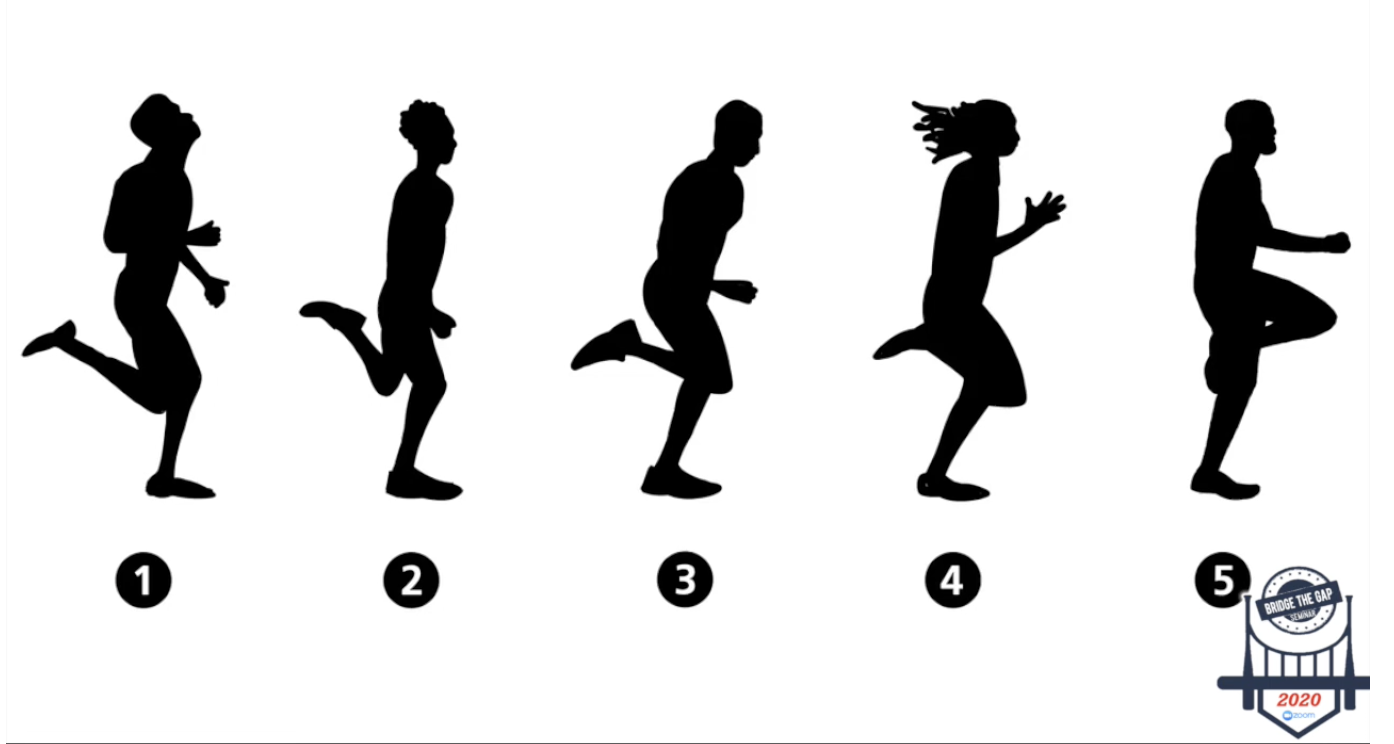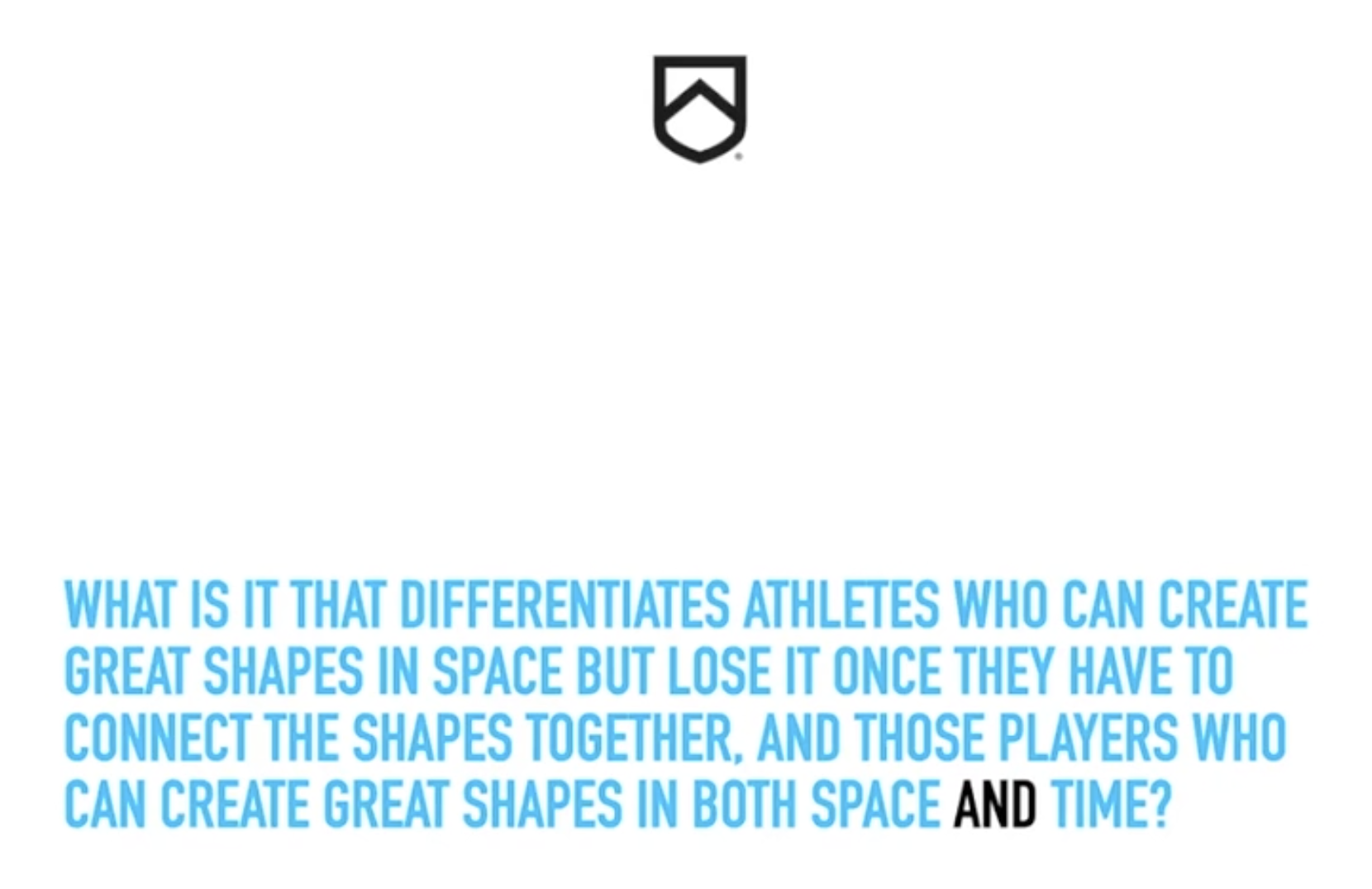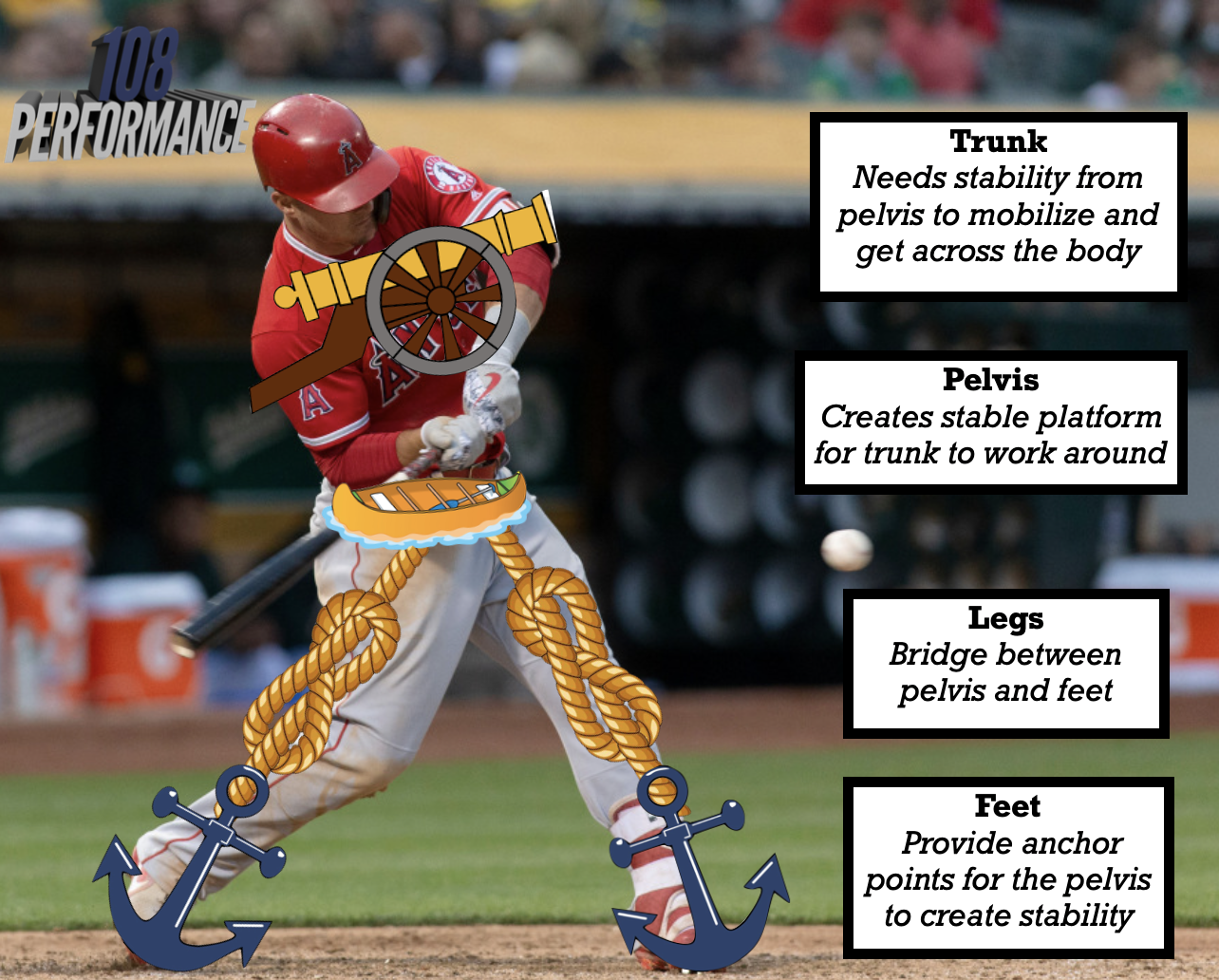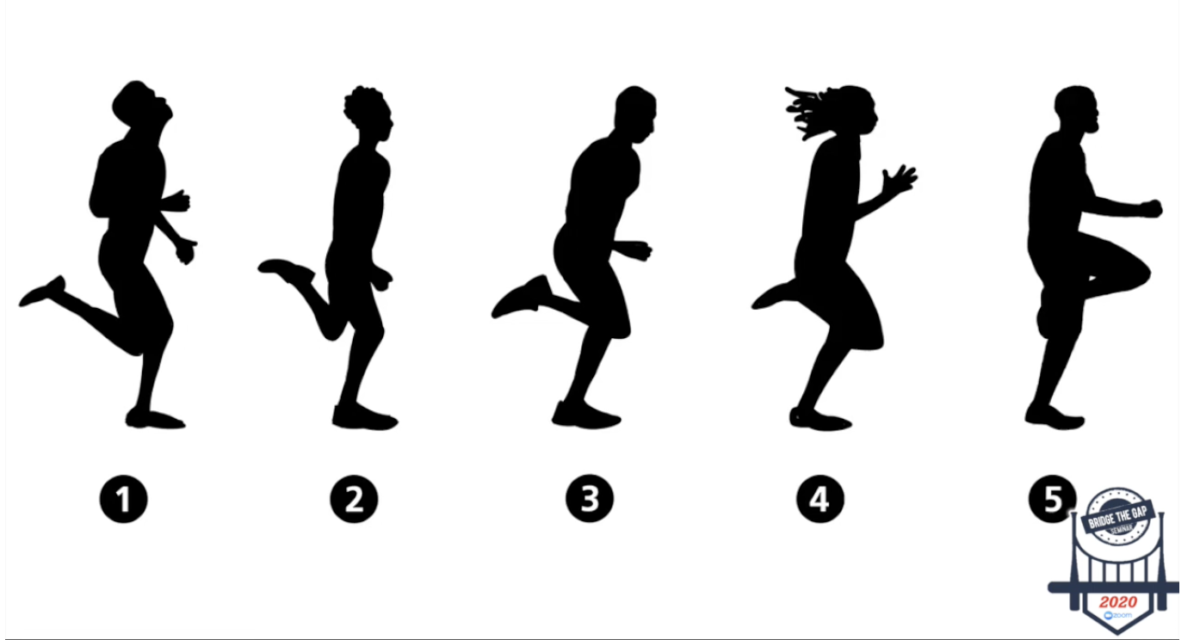At 108 Performance we recently held our fourth annual Bridge the Gap (BTG) conference the weekend of October 23-25. Over the course of three days we were able to gather 37 of the brightest minds in player development who put together 27 information packed presentations. For those of you who missed out, we went back through and decided to recap highlights from some of the presentations throughout the weekend.
First up is Stuart McMillan, CEO and Sprint Coach for ALTIS. Stuart has had the ability to coach 60 Olympians at six different Olympic Games with 30 of those athletes winning medals. Through his observations he has noticed how his elite level sprinters all share distinct patterns of shapes at key moments in space. What’s interesting about these shapes is they aren’t just recognizable among the eyes of trained coaches. Out of the five shapes below, try picking out which one is from an elite sprinter:

Did you pick number five? Odds are, you probably did.
Without having any other context you picked up on certain features (e.g. upright torso, neutral head/pelvis) that we typically recognize as synonymous with good running mechanics. This happens because our brain is the ultimate pattern recognition system. We know what good movement looks like – even if we can’t exactly put our finger on what we’re seeing – because our brain is constantly cataloging patterns that we pick up subconsciously through our experiences. This is where shapes come into play.
If we want to understand sport specific movement we need to first start with the most stable components of it. These are what Stuart refers to as shapes. They give us information for how an athlete organizes their body to accomplish motor tasks through space. To put it very simply, shapes are the foundation. From this foundation we can build patterns – how the body navigates space and time to complete a motor task. Time thus becomes very important. All sports have some sort of a time constraint in which athletes must learn how to navigate. If the shapes hold steady independent of time but break down when a time is introduced, you’ve created a situation where training does not transfer to games.
So, the question becomes this:

Dan Pfaff – Director of Education and Head Jumps Coach at ALTIS – was also able to join us for Bridge 2020. Throughout his coaching career he has coached 49 Olympians, 29 individual NCAA National Champions, 150 NCAA All-Americans, and has served on five Olympic games coaching staffs. One of the things he talked about was the allowable bandwidth for movement. While we recognize there are fluctuations in movement signatures from player to player, Pfaff brought up a great point he picked up on through his observations retraining injured military veterans to walk again. What he realized was the gait cycles he studied were all very similar. “There aren’t 10,000 ways to walk,” said Pfaff.
This brings up an interesting parallel to baseball. While we know everyone has their own unique movement signature, there might not be as much variation as what we originally thought. The bandwidth might be a lot smaller. Throwing or hitting a baseball is much more complex than walking, but we know there are fundamental movements (i.e. shapes) that all elite throwers and hitters share. Starting here gives us a foundation that can help us understand the subtle nuances better, but we can’t just know what’s different. We also need to know the allowable bandwidth for what is different.
Pfaff also touched on Stephen Levin’s concept of biotensegrity – something he feels isn’t talked about enough. The human body is a tensegrity model where the collagen matrix (e.g. fascia) becomes the glue that keeps structural integrity in our body. Tension plus integrity is where tensegrity comes from. For Pfaff, knowing this is important because gives us a completely different perspective on how the body operates as an interconnected, dynamic system. This helps us better understand how the body disperses stress, produces “free energy” through the fascial system, and how certain injuries can present as problems in different areas of the body. The more we look at the body as a living and breathing tensegrity unit, the better we can understand how to influence human movement.
One of the most exciting part of the weekend was the Biomechanics panel Friday evening that featured three influential doctors in the baseball community: Greg Rose of TPI and OnBaseU, Jimmy Buffi of Reboot Motion, and Emily Ferree of Movement First. One of the topics discussed was the idea of sequencing and how speed gains can be inflating. Instead of looking at the sequence of speed, Jimmy Buffi likes to look at the sequence of momentum because it takes into account mass. In order to determine how much power an athlete creates speed and mass must be taken into account. Just looking at speed by itself can give us a false illusion for how a hitter produces power because athletes with less mass are going to have faster speeds. Pro range speed gains do not correlate to pro range outputs.
This is something that Bobby Tewksbary and Chris Colabello touched on in their presentation because they noticed how a lot of their youth hitters had peak speeds in the pro ranges. In fact, the highest exit velocity they ever recorded in their shop (108 mph) was from an athlete who had the lowest peak pelvic speed they had ever measured. This is exactly what Buffi was talking about.
Teaching players how to move the middle shouldn’t just focus on the pelvis. To really move in the middle you need to teach the trunk how to fire around a stable pelvis.
Something else Eugene brought up was his new understanding of a concept Greg Rose introduced him to: Torso acceleration drives pelvis deceleration. The muscles that are responsible for the rotation of the trunk are the oblique abdominals. These muscles attach from the rib cage down to the pelvis. For a muscle to mobilize one end of it must have stability. In this case, the oblique abdominals need stability from the pelvis to drive trunk rotation from the rib cage. One end must be stable for the other end to be mobile, which means one segment must accelerate for the other to decelerate. The pelvis doesn’t stop and drag the upper body along for the ride. The acceleration of the trunk helps the pelvis stop and decelerate. Teaching players how to move the middle shouldn’t just focus on the pelvis. To really move the middle you need to teach the trunk how to fire around a stable pelvis.

People have overlooked this largely because baseball biomechanics has focused primarily on “what” variables as opposed to “why” variables. Emily Ferree talked about this saying it’s one thing to know the pelvis goes and stops first. It’s another to understand the reason why the pelvis stops first might have nothing to do with the pelvis. Focusing on the end product causes us to lose touch with the process to get to the end product. We can’t just know what happens – we also need to understand why.
Eugene Bleecker talked about this using his biomechanics analogy of combining A-Rod with Albert Einstein. If you could take someone like A-Rod with his experience and knowledge in the game and combine it with someone like Einstein who understood how to measure the things that were really important to A-Rod, you’ve created a scenario where you’re measuring the things that matter. If we don’t want biomechanics to become just a bunch of numbers and data points, people with skin in the game must learn to drive the interventions. Giving scientists the task of dissecting a sport in which they have little to no knowledge of is a great recipe for getting lost in data. Pairing them with an elite player – or coach – gives you the ability to filter that data.
If you could take someone like A-Rod with his experience and knowledge in the game and combine it with someone like Einstein who understood how to measure the things that were really important to A-Rod, you’ve created a scenario where you’re measuring the things that matter.
This was the main point behind Bobby Tewksbary and Chris Colabello’s presentation. If you’re looking at numbers without understanding the context behind those numbers, you’ve created a situation where you’ve become slavish to what is measurable. They explain this by using an analogy: “If you play stupid games you win stupid prizes.” Before we dive into data, we have to understand what the main goal is. The objective is not to add 3 mph of exit velocity or 10 degrees to your Vertical Bat Angle (VBA). It’s to get hits at 7 o’clock. Using information to help you accomplish this creates positive training interventions. The data you collect shouldn’t be an outcome in itself. It should be a way to influence positive outcomes in games.
Interested in more? You can get full access to all 28 presentations from Bridge the Gap 2020 using the link below.

